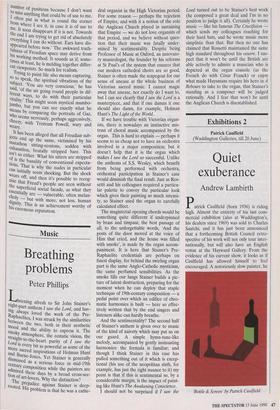Music
Breathing problems
Peter Phillips
Lstening afresh to Sir John Stainer's Fight-part anthem I saw the Lord, and hav- ing always loved the work of the Pre- Raphaelites, I was struck by the similarities between the two, both in their aesthetic mood and the ability to express it. The smoky atmosphere, the ecstatic vision, the straight-to-the-heart purity of I saw the Lord is every bit as powerful as some of the more sacred inspirations of Holman Hunt and Bume-Jones. Yet Stainer is generally dismissed as a serious force in mid-19th century composition while the painters are admired these days by a broad cross-sec- tion of art-lovers. Why the distinction? The prejudice against Stainer is deep- rooted. His problem is that he was a cathe- dral organist in the High Victorian period. For some reason — perhaps the rejection of Empire, and with it a notion of the role the Anglican Church played in sustaining that Empire — we do not love organists of that period, and we believe without ques- tion that their music was fatally under- mined by sentimentality. Despite being Professor of Music at Oxford, an innovato- ry musicologist, the founder by his reforms at St Paul's of the system that ensures that our modern cathedral choirs are so good, Stainer is often made the scapegoat for our sense of unease at the whole business of Victorian sacred music. I cannot magic away that unease, nor exactly do I want to, but I can see clearly that I saw the Lord is a masterpiece, and that if one damns it one should also damn, for example, Holman Hunt's The Light of the World.
If we have trouble with Victorian organ- ists, there is nowadays an instinctive mis- trust of choral music accompanied by the organ. This is hard to explain — perhaps it seems to us cheap not to have an orchestra involved in a major composition; but it doesn't help that it is the organ which makes I saw the Lord so successful. Unlike the anthems of S.S. Wesley, which benefit from being performed with orchestra, orchestral participation in Stainer's case would diminish the final result. Just as Ros- setti and his colleagues required a particu- lar palette to convey the particular look which gives their painting so much intensi- ty, so Stainer used the organ to carefully calculated effect.
The magisterial opening chords would be something quite different if underpinned by brass and timpani; the best passage of all, to the unforgettable words, 'And the posts of the door moved at the voice of Him that cried, and the house was filled with smoke', is made by the organ accom- paniment. It is here that Stainer's Pre- Raphaelite credentials are perhaps on finest display, for behind the swirling organ part is the same Anglo-Catholic mysticism, the same perfumed sensibilities. As the smoke fills our lungs Stainer builds a pic- ture of latent destruction, preparing for the moment when he can deploy that staple technique of 19th-century composition — a pedal point over which an edifice of chro- matic harmonies is built — here so effec- tively written that by the end singers and listeners alike can hardly breathe.
And the sentimentality? The second half of Stainer's anthem is given over to music of the kind of naivety which may put us on our guard. A simple hymn-tune-like melody, accompanied by gently insinuating harmonies: the formula is familiar; and though I think Stainer in this case has pulled something out of it which is excep- tional (his use of the neopolitan sixth, for example, has just the right nuance to it) my point is that if this is sentimental so, by a considerable margin, is the impact of paint- ing like Hunt's The Awakening Conscience.
I should not be surprised if I saw the Lord turned out to be Stainer's best work (he composed a great deal and I'm in no position to judge it all). Certainly he wrote music — like his famous The Crucifixion which sends my colleagues reaching for their hard hats, and he wrote music more simplistic than that. But then no one has claimed that Rossetti maintained the same high standard throughout his oeuvre. I sus- pect that it won't be until the British are able actively to admire a musician who is depicted at the organ console (as the French do with Cesar Franck) or enjoy what made Huysmans require his hero in A Rebours to take to the organ, that Stainer's standing as a composer will be judged rationally. And I fear that won't be until the Anglican Church is disestablished.


































































 Previous page
Previous page